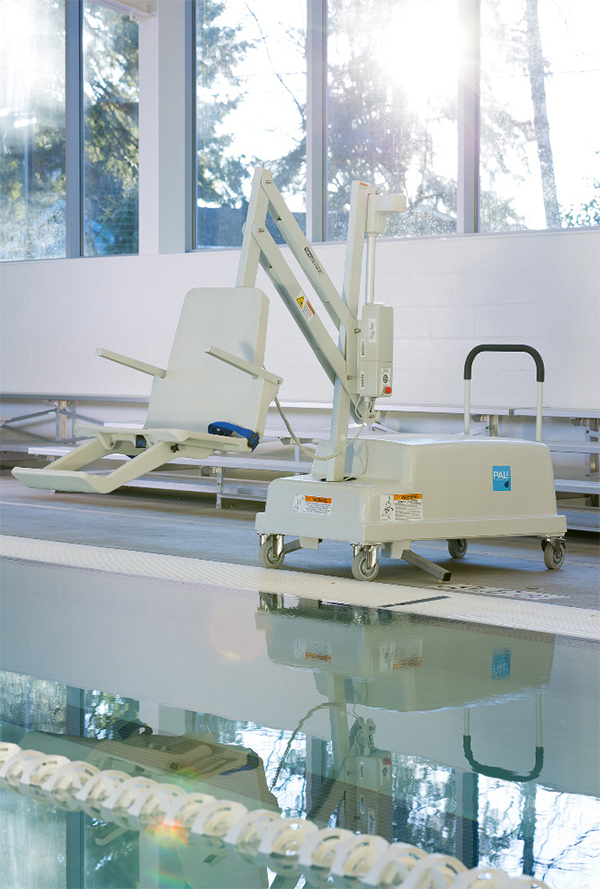Care and Maintenance for Swimming Pool Lifts
Routine pool lift maintenance and cleaning are an important part of ensuring the equipment that provides accessibility for all remains in good working order. Regular service helps prolong the life of your pool lift, supports daily operation and helps satisfy the ADA’s provision for the maintenance of accessible features.
Maintenance Schedule
The pool lift should be inspected daily for loose or missing hardware, proper function and battery charge status. Each day you should thoroughly rinse all external lift components with fresh water.
On a weekly basis, wash all external lift components with warm fresh water containing mild soap. Use a soft cloth along with the cleaning solution to wipe down all lift component surfaces. In some cases, it may be necessary to use a soft nylon brush to remove rust or staining. It is recommended that the stainless steel actuator tube be cleaned when the actuator is in its fully extended position so that the entire length of the actuator tube is exposed.
Note: the required frequency of the cleaning depends upon the environment where the pool lift is installed. Check out the Pool Lift Maintenance Guide for the best maintenance schedule for your pool environment. In cases where the corrosion factor is mild you may only need to clean your pool lift monthly.

Monthly inspection of the lift should be done to ensure that there is no excessive corrosion occurring on the lift which could compromise the lift’s structural integrity. For units that have plastic covers, the covers should be removed or lifted so that the hidden parts of the structure can be inspected. If any components show excessive corrosion or wear, contact your authorized S.R.Smith dealer for replacement components.
How to Clean a Pool Lift
After all surfaces have been wiped down with the cleaning solution, thoroughly rinse the entire lift with fresh water. A quality automotive wax may be applied to help maintain the finish of the lift between scheduled cleanings. Metal lift components that are not powder coated, including hardware, are more susceptible to corrosion and staining. It is recommended that particular attention be paid to these components when cleaning. Using a cleaner such as Bon Ami® to clean the non-powder coated surfaces will help to minimize corrosion and maintain the appearance of the parts.
Do not use: chloride containing cleaners on metal components, abrasive cleaners, or steel wool. All of these things can cause damage to the surface of the lift components and promote further corrosion.
Inspecting and Maintaining the Pool Lift Battery, Controller and Gears
Keeping your battery charged is critical to maintaining function of the lift. Allowing the battery to fully discharge will damage the battery. The battery should be charged when not in use, or when the pool is closed. It is also recommended to have a spare battery so that one can be charging while the other is in use, or in case that one battery fails. The batteries should be swapped daily with one battery always charging.
Temperature extremes will affect battery life and performance. In regions where temperature extremes are common, it is recommended that the batteries be kept in a temperature controlled environment when they are not in use or while they are charging.
It is also important to make sure that the battery and controller terminals are kept clean to ensure that they are making electrical contact. The battery and controller terminals should be checked weekly for any sign of dirt or corrosion build up. To clean the terminals, a small plastic bristled brush or nylon scouring pad can be used to gently remove any build up on the terminals. If your battery or controller terminals are showing any signs of corrosion, it is recommended that dielectric grease be applied to the terminals to inhibit further corrosion.
For lifts that have rotational movement in addition to lifting movement (PAL, Splash! and aXs Lifts), it is important to check that the gears are in good working order and not showing signs of excessive corrosion. The gear assemblies should be inspected monthly to verify their condition. If necessary, use a plastic bristled brush to remove any buildup of rust or other material and use LPS® 3 corrosion inhibitor, or similar product to prevent further corrosion.
